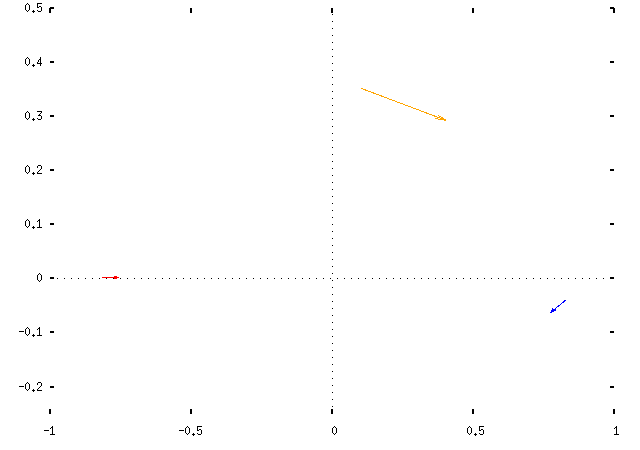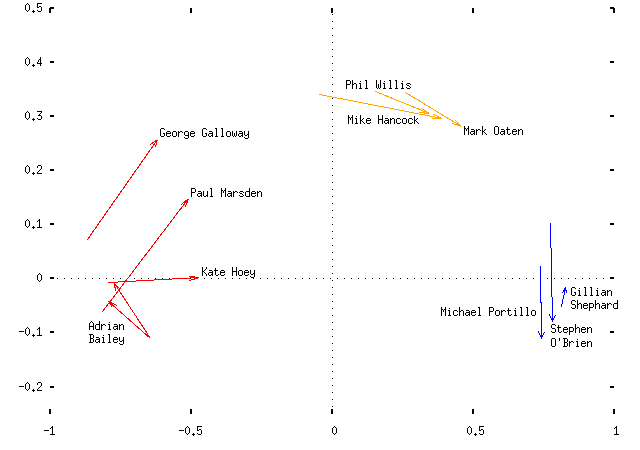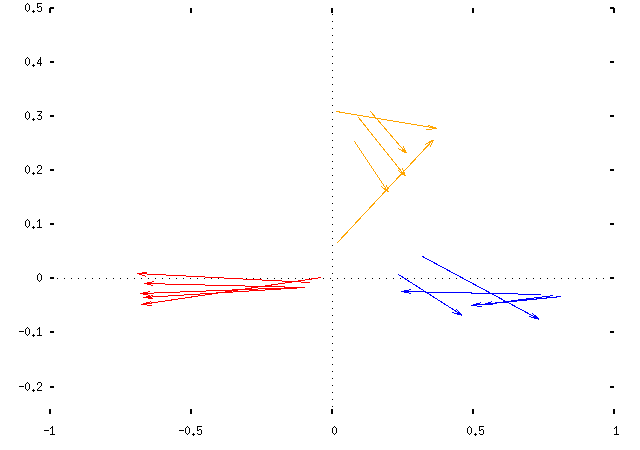As a piece of incestuous web-logging commentary, I'd like to thank whichever of my half-dozen readers nominated me for the Guardian's political web log awards. However, the major effect of discovering this has been to make me feel guilty that I haven't written anything for the past few days (and that the last time that I did I made a glaring error). Oh dear. So I'll just pad this out by publishing something Tom asked about, relating to my piece on parliamentary coordinates.
Tom wanted to know which MPs have moved the greatest distance between the 1997 and 2001 Parliaments. This isn't a completely meaningful question, because the axes for the two Parliaments are quite different (they're defined by distinct sets of divisions). However, because the two axes seem to maintain their rough meaning between the two Parliaments, it's still possible to go through this exercise, though I'm not sure how useful it is.
Firstly, as mentioned before, the parties move a bit in total. Here's the mean change in position for the three major parties from 1997 to 2001:

To pick out `interesting' MPs from this bunch, I've looked for the MPs who moved the greatest distance relative to their party. (This is completely ad-hoc, by the way, and I'm not going to attempt to justify it.) Anyway, here are the results:

I've picked out the few most mobile MPs of each party. Some observations: (these are fairly tenuous; you may be able to draw your own, more interesting, interpretations; feel free to drop me a line)
Paul Marsden defected from Labour to the Liberal Democrats. George Galloway was kicked out of the Labour Party because of his stance on Iraq. Kate Hoey is pro-hunting, and that turns out to be very important on the x-axis in these plots. (Anne Widdecombe, who is anti-hunting, comes out left of the Tory pack for the same reason, though that's not shown in the above plot.)
Phil Willis and Mark Oaten both acquired front-bench jobs in the 2001 Parliament. Mike Hancock joned the defence Select Committee. I suspect that's responsible for their larger-than-average changes in position (but I haven't checked). (By the way, the Guardian's Aristotle tool is good for checking this sort of information; from Google, you can usually just type the MP's name and the word `Aristotle', then hit `I'm Feeling Lucky'.)
Michael Portillo left the front bench in 2001, yet moved in roughly the same direction as Stephen O'Brien, who became a whip in 2001, then Shadow Secretary of State for Industry in 2003. This is slightly surprising, and I don't know why it happened. Gillian Shephard (who didn't move very far, to be honest) returned to the back benches in 1999, which may explain the change.
Incidentally, in the above plots, I've used the same dodgy scaling I described in the previous discussion. Skipping this yields a plot which is dominated by MPs whose attendance record has changes:

-- so I'm content that the scaling, though dodgy, is useful.
If you'd like a copy of my processed data, please email me. You can also get various raw data from the Public Whip site.